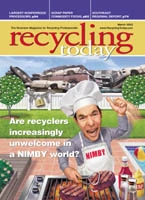There is a movement out there among state regulators to consider banning the disposal of waste gypsum from landfills. They would be following the example of British Columbia, where gypsum is not allowed in landfills. And in Massachusetts, the state may implement a ban of many components of the C&D waste stream from being disposed of in landfills. That effort is to promote recycling. One material not part of the proposed ban, but only because there is no central collection point and limited markets for it, is clean gypsum. Otherwise, the Massachusetts Department of Environmental Protection almost certainly would include gypsum in the ban.
Similar actions are being considered from Florida to Washington state, in various phases of heading toward implementation. But the point is that many state environmental agencies want gypsum out of landfills, and not just because they are pro-recycling. They want it out because in the landfill environment, gypsum, especially when mixed with moisture, is a leading cause of the development of hydrogen sulfide gas.
Now by itself hydrogen sulfide is not a killer. Theoretically it could fell a person who was inhaling it at a concentration level that is typically very difficult to attain, according to Dr. Timothy Townsend, University of Florida., who has done considerable research on gypsum. It is even debatable just how harmful long-term, low-level exposure to the gas is. But the real worry is the smell, which is like rotten eggs on steroids. It is truly awful and a nuisance to anyone downwind of a landfill. This leads to complaints against a facility, so landfill operators have an incentive to keep something like that out of their landfills.
It also provides an opportunity for mixed C&D recyclers. An example is CMRA member Taylor Recycling Facility in Montgomery, N.Y. When the company went seriously upscale in building its new processing plant more than a year ago, it also worked aggressively to develop markets for waste gypsum.
Why? It wanted to keep the material out of one of its main end products, alternative daily cover (ADC). The company knew it would have a marketplace advantage over its competitors if its ADC didn’t have the odor-causing material in it. (For more information, see C&D Recycler, July/August 2002, page 20.)
Another example comes from a new CMRA member, New West Gypsum, a long-time gypsum recycler that has successfully been providing wallboard manufacturers with processed gypsum for feedstock. Another method is used by CMRA member Patterson Services, Mableton, Ga., which brings a small grinder onto a construction site, processes the gypsum right there, and then works the gypsum into the ground at the site.
We are asked all the time about trends in C&D recycling and new opportunities. We suggest that all mixed C&D recyclers should start now trying to figure out ways to sort out, process and market waste gypsum before a ban is planned.
For its part, the Construction Materials Recycling Association will be partnering with the U.S. Environmental Protection Agency, WasteCap Wisconsin, and the University of Florida to create a Web site that will provide all known information about gypsum recycling in one place. But the smart operators out there will get cracking on the project now.
Get curated news on YOUR industry.
Enter your email to receive our newsletters.
Explore the March 2003 Issue
Check out more from this issue and find your next story to read.
Latest from Recycling Today
- ReMA opposes European efforts seeking export restrictions for recyclables
- Fresh Perspective: Raj Bagaria
- Saica announces plans for second US site
- Update: Novelis produces first aluminum coil made fully from recycled end-of-life automotive scrap
- Aimplas doubles online course offerings
- Radius to be acquired by Toyota subsidiary
- Algoma EAF to start in April
- Erema sees strong demand for high-volume PET systems






